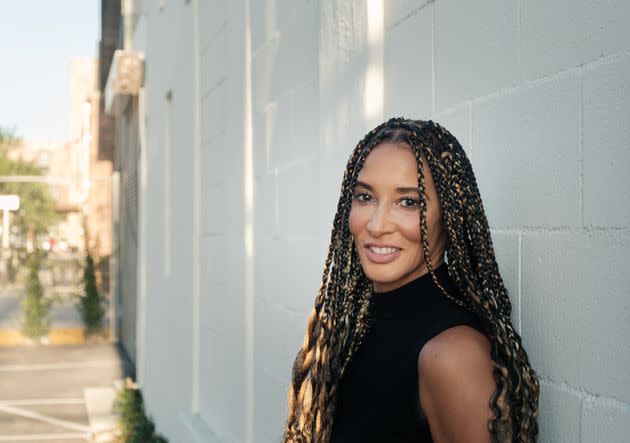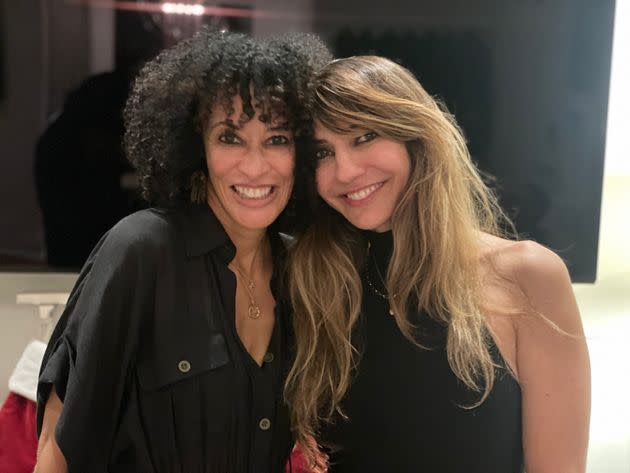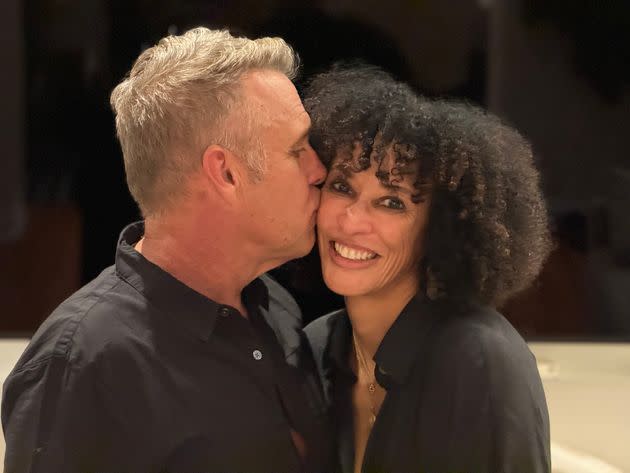I Became Friends With A White Woman. Then 1 Cringeworthy Conversation Changed Our Relationship Forever.

Kim (not her real name) and I bonded when our sons played on the same travel basketball team. For years, we spent weekend after weekend together in loud, testosterone-filled gyms, rife with the smell of boy sweat and breakfast sandwiches. We always sat in the same place on the unforgiving bleachers, midway up in the center, and picked up our conversation from where we left off at the previous practice or game. Sometimes we lightly trashed the coaches, chastising them for how they ignored our respective son’s potential and didn’t give them enough playing time. But mainly we gossiped about the other parents (quietly and sometimes in code).
And when we were out of earshot, we discussed our love lives: new relationships (hers) and divorces (mine). Kim had dated several men, but she seemed to be smitten with this latest one, a single dad and a former University of Iowa college basketball player.
I saw Evan for the first time when he showed up at practice to bring her wallet. I grinned when she leaped up and shrieked at the sight of his 6-foot-something frame filling the gym’s doorway. She was so tiny next to him that they reminded me of Isla Fisher and Sacha Baron Cohen, if they were both blond.
To me, Kim was the only thing that made those practices bearable. So when she missed two in a row, I called her in a panic.
“I’m Evan’s plus one at a wedding in San Jose!” She was yelling over Montell Jordan’s “This Is How We Do It.” “Sorry, didn’t I tell you? Anyway, I’ll be back in time for tomorrow’s practice. I can’t wait to process everything with you.”
Process?
When Kim arrived the following day, I felt my shoulders relax as she sat next to me. Another mom had been vying for Kim’s spot and I didn’t know how much longer I could hold her off without being rude.
“So what happened?” I whispered, sneaking a glance at her left hand to see if maybe she’d gotten engaged. We were sitting with our heads together conspiratorially, like teenagers in homeroom.
“I couldn’t wait to see you. I thought about you the whole time I was there.”
“About me? Why?”
“It was a Black wedding.”
I watched Kim’s mouth continue to move while my stomach turned to jelly.
Oh no.
As someone who grew up Black in white spaces, I’m accustomed to white people seeking me out to marvel at their experiences with Black people and culture. Once, at a school board meeting, a white man crossed the room just to let me know that he’d tried collard greens for the first time.
Another time, an older white woman at a party informed me (without prompting) that she’s started going to Black salons because they know how to do curly hair. Whenever I have braids, white women have no problem asking if it’s my “real” hair. And white men can’t wait to tell me about their Black girlfriends to illustrate how “down” they are for knowing about locs and shea butter.
Most of the time, I see that the offender is actually attempting to bond with me, and I try not to discount that. But I’d never pegged Kim as one of those “well-intentioned white people.” I’d let my guard down with her and I was about to find out what a mistake that was.
“Girl, Evan and I were the only white people there. It was crazy! I mean, don’t get me wrong, the wedding was beautiful.”
Why do you sound surprised that the wedding was beautiful?
“They jumped the broom like in ‘Roots,’ did you ever see that TV show?”
Of course, everyone who was alive in the 1970s saw “Roots.”
“It was so cool. The whole buffet was soul food, I tried fried catfish and I never ate so much mac and cheese.”
OK, you really need to stop.
“Everyone was singing along with the music during the ceremony; they had this gospel choir! And the woman next to me yelled, ‘Go head, y’all’ when the bride and groom kissed.”
Don’t EVER do that. Imitate Black people.
“And at the reception, they did something called the Cupid Stumble.”
“Shuffle,” I said through gritted teeth. “It’s the Cupid Shuffle.”
I felt my chest heating up.
Does she know how many white weddings I’ve been to with a smile pasted on my face? What if I went to Kim after one of them and said, “Wow! I went to this white wedding and I was the only Black person there, isn’t that crazy? Oh, and they had flavorless mashed potatoes and dry, skinless chicken breasts, have you ever had that?” Or, “I couldn’t believe how stiff and silent everyone was during the ceremony.”
With one wedding, I’d transformed from Kim’s friend to Kim’s Black friend, and I knew our relationship would never be the same.
According to the Public Religion Research Institute, 75% of white people have no friends of color, a statistic I find both startling and consistent with my experience. Typically, building interracial friendships means that both parties need to put in work. Both need to step outside their respective comfort zones to learn and embrace a culture with which they may not be familiar. Ideally, that means my white girlfriends and I would spend equal time in each other’s worlds, acquainting ourselves with things like the other’s music, food, news and fashion.
But that’s rarely how it goes.
Mostly, it’s just me, meeting my white friends at white restaurants, discussing white TV shows on our group texts, and going to white book events in white parts of town. Rarely do they choose films like Ava Duvernay’s “Origin” or suggest going to a reading by a Black author like Ashley C. Ford. And as the Black, female TikTok creator @bannebean posted recently on this topic, “I’m getting tired of having to be in white spaces to maintain the friendship.”
Facts.
Like the old adage about the tree falling in the forest, I wonder if an interracial friendship that takes place only in white spaces is a true friendship. The assumption is that your Black friend is comfortable everywhere you are, when they may just have more practice at being comfortable with being uncomfortable. Being Black in white spaces comes at a cost, and it seems Black people are always expected to foot the bill.
I met Lilah almost 15 years ago.
“You are stunning,” she said to me, looking me up and down. We had just arrived at a mutual friend’s baby shower. “I want your skin. It’s amazing.”
I studied her, sizing up her large green eyes and waist-length light brown hair, and decided that I should lightly and politely remove myself from the conversation. I didn’t feel like being fetishized for my skin or hair or anything else. I didn’t want to be the Black friend at this baby shower. I just wanted to be.
But Lilah didn’t just let me be.

During the party, Lilah sat with me on a love seat and talked like we were old friends. She spoke about current events like my Black friends do, outraged by the same policies and politicians, sympathetic to the same causes. When the shower givers asked someone to lead the limbo, Lilah went first, dancing like she was born in Trinidad instead of Orange County.
As time went on, I discovered that Lilah is no ordinary white woman. First of all, she’ll be the first to tell you that she’s mixed race, with a Swedish mother and an Armenian father. Secondly, she is 100% down for going “culture-halfsies” where our friendship is concerned.
I don’t think it would ever occur to her that we only go to white restaurants, white concerts or parties filled only with white people. She’s always down to see what’s new on the menu at Keith Corbin’s Alta Adams here in LA, or accompany me to see Tyla at The Wiltern. She insists on a balance, making sure our friendship isn’t one-sided.
Obviously, one shouldn’t ever walk up to a stranger or even a new Black friend and offer to share a hot new restaurant with them just because it’s “Black.” (Otherwise you risk coming off like Kim or the gentleman with the collard greens.) Over the last 15 years, Lilah has proved over and over again that her enthusiastic interest in everything that makes me me, including my Blackness, comes from a place of friendship and not “festishship.”
During these times of political conflict in our highly segregated society, true interracial friendships are rare.
And interracial romantic relationships might be even rarer. I’m not talking about someone dating outside of their race; there’s plenty of that. I’m talking about a true romantic partnership, where, for instance, a white man steps out of his comfort zone to embrace his Black partner’s family, food, sports, music and entertainment.
Yes, I’m talking about my boyfriend.
Scott and I met nearly 16 years ago. At the time, he lived in Utah and he was the whitest man to whom I’d ever been attracted. Because of that, I thought it would never work between us. But, as time went on, I became besotted with him, which was both thrilling and terrifying. Because I agreed with Tina Turner when she said, “What’s love got to do with it?” — I had no faith that love could bridge our cultural divide, even a love as great as ours.

Scottie comes from a quiet, three-person home, just him and his parents, who have now both passed. My family is loud. And when the 10, sometimes 15, of us get together (every week), there are spirited, sometimes raucous debates about everything from WWE to the race for the White House. At first, Scott would just kind of drift away during the chaos and watch TV in another room. Later he stayed in his seat during these verbal rows and listened to each person’s (emphatic) point. He told me recently that the most important lesson he’s learned from being around my family is listening, really listening.
But over the years, he started participating in the debates and voicing his opinion. It’s hard to get a word in edgewise in my family, but somehow he manages. When it comes to seeing Black theater or movies, he’s gone from “going along” to surprising me with tickets to shows like “Slave Play” and “Raisin in the Sun.” It’s not that he’s changed who he is. But instead of asking me to change who I am by giving up my Blackness, he loves me all the more for it.
Halfsies.
The Kim of it all aside, I think that I am better because of my interracial relationships. Lilah and I are not only besties, but we are also allies and advocates for each other’s cultures. And I think that my relationship with Scott challenges the status quo and demonstrates that race need not be a barrier to love if both parties are willing to work.
When I’m out in the world, everywhere I look I see people gravitating toward the familiar. But the payoff for intentionally widening your friend circle can be immense. I’d love to see our society normalize transracial friendships that allow each person to live authentically. My relationships with my non-Black friends, while sometimes hard-earned, have been some of the richest of my life. There is so much to be gained by knowing and loving someone different from you.
Laura Cathcart Robbins is the bestselling author of the Atria/Simon & Schuster memoir “Stash, My Life in Hiding” and host of the popular podcast “The Only One in the Room.” She has written recent articles on the subjects of race, recovery and divorce. Find out more on her website, lauracathcartrobbins.com, or you can look for her on social media.
Do you have a compelling personal story you’d like to see published on HuffPost? Find out what we’re looking for here and send us a pitch at pitch@huffpost.com.

